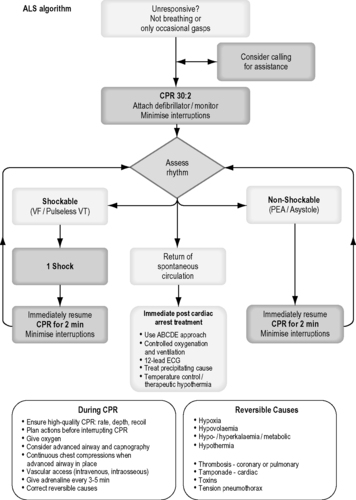Chapter 14. Cardiac arrest in adults
Advanced life support
The chances of surviving an out of hospital cardiac arrest are 1:100. The paramedic has two challenges:
1. To recognise and intervene appropriately in the care of the critically ill patient in order to prevent a cardiac arrest occurring
2. To respond promptly and skillfully to patients in cardiac arrest in order to optimise their chance of survival.
Defining cardiac arrest
• Cardiac arrest may be defined as the absence of a palpable pulse in an unresponsive patient. The pulse check is an unreliable sign if used in isolation from the clinical setting
• Lay rescuers are no longer taught to use a pulse check to verify cardiac arrest. Instead, they start chest compressions if there are no signs of circulation (such as normal breathing, coughing or movement)
• Paramedics should not rely solely on the pulse check to diagnose cardiac arrest, but should look for other indicators that the circulation has failed.
Cardiac arrest rhythms
Electrocardiogram (ECG) monitoring in cardiac arrest will establish the initial rhythm, which will be one the following:
• Obstructed airway
• Myocardial infarction, unstable angina
• Peri-arrest arrhythmia
• Status asthmaticus
• Status epilepticus
• Uncontrolled haemorrhage
• Anaphylaxis.
1. Ventricular fibrillation (VF)
2. Pulseless ventricular tachycardia (VT)
3. Asystole
4. Pulseless electrical activity (PEA).
For treatment purposes, these rhythms are divided into:
• Shockable (VF/pulseless VT)
• Non-shockable (PEA or asystole).
The initial rhythm of a patient in cardiac arrest will determine which treatment algorithm is used first.
Chain of survival
The aim is a return of spontaneous circulation (ROSC). Factors that are likely to result in a successful ROSC are:
1. Immediate basic life support including effective CPR. This means the patient stays in a shockable rhythm for longer
2. Fast defibrillation. Automatic external defibrillators are increasingly available in public areas for this reason
3. Early advanced life support. Successful intubation, oxygen and adrenaline will improve patient outcomes
4. Transfer to hospital. The underlying cause needs to be identified and treated.
The advanced life support approach
• SAFE approach
• Establish unresponsiveness
• Open the airway
 |
| Figure 14.1. |
| The adult advanced life support algorithm (Resuscitation Council UK). The authors are aware of impending changes in resuscitation guidelines (late 2010). Refer to: www.resus.org.uk for further up-to-date information. |
• Assess breathing
• Attach monitor and assess the circulation.
Continue CPR with as few interruptions as possible. If good-quality bystander CPR is in progress, then encourage them to continue until the paramedic team is ready to take over. Apply defibrillating gel pads immediately to identify a shockable rhythm.
Once the patient is confirmed to be in cardiac arrest, he should be treated according to the initial rhythm.
Shockable (VF or pulseless VT)
Precordial thump
If a cardiac arrest is witnessed and monitored then a precordial thump may be administered. It should not delay, however, calling for help or accessing a defibrillator. This is equivalent to a low-energy defibrillatory shock and may revert a patient in the early stages of VF or VT to a perfusing rhythm. The thump should be given in the normal position for chest compression from a height of approximately 20 cm above the chest, using a closed fist.
Defibrillation
• VT without cardiac output will rapidly degenerate into ventricular fibrillation
• Defibrillation is the same for both conditions
• Success is greatest if a shock is applied within the first 90 seconds of the arrest
• Chances of successful defibrillation decline by about 10% per minute thereafter
• Single shocks are delivered and CPR is continued for 2 minutes. Only after one cycle (2 minutes) are checks made for a cardiac output. This is because even after successful defibrillation the heart will not function effectively for the first minute (myocardial stunning/cardiac standstill).
Adrenaline
• Adrenaline is the first-line drug in cardiac arrest in the UK. In cardiac arrest, its greatest effect is through peripheral vasoconstriction which raises the systemic vascular resistance, hence increasing cerebral and coronary perfusion during CPR
• When treating VF/VT cardia arrest, adrenaline 1 mg is given once chest compressions have restarted after the third shock
• 1 mg doses should be administered IV every other cycle (every 3–5 minutes), preferably not at the exact same time as a defibrillation shock
• Adrenaline can be administered by the intraosseous route if peripheral cannulation is unsuccessful
• Higher doses of adrenaline are not recommended.
Amiodarone
Buy Membership for Emergency Medicine Category to continue reading. Learn more here


